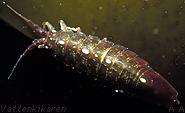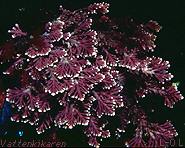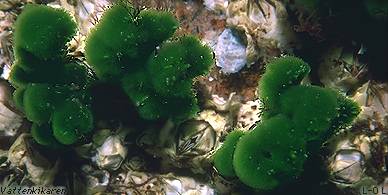
Isopods (Idotea spp., approx. 3 cm long) are one of the few
animals that are able to eat fresh algae.
For certain crustaceans (e.g. rock lice), shelfish (e.g. Blue-rayed
limpet) and sea-urchins (e.g. Psammechinus
miliaris), algae is an important food source.
Because grazing can injure algae, it is natural that
they try to protect themselves. This is made possible by the tissues
storing hard and distasteful calcium. This type of protection is utilized
by encrusting
red alga and the coral alga, Corallina officinalis.
The body form of the alga is also a factor that effects
how easy they are to eat. |

The large amount of calcium in coral alga makes it hard and distasteful.
These plants are about 10 cm high.
It can, for example, be difficult to eat tufts that are short and
thread-like. Another form of protection is to use unpleasant or poisonous
chemicals. There are specie that contain one or more of the following
chemicals for protective use: sulphuric acid, alkaloid, phenol
or chlorine, bromine and iodine compounds. |



